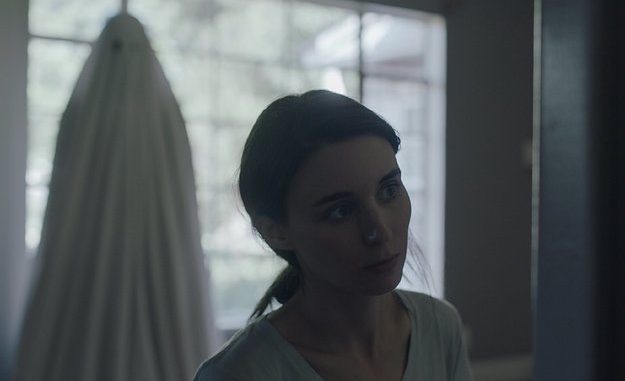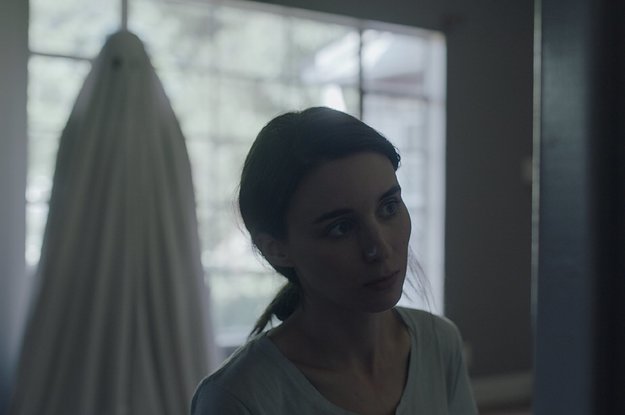

Casey Affleck dies and is transformed into a ghost early in A Ghost Story. He doesn’t become a glowering ghoul or see-through specter, but a ghost by way of the Halloween costumes in It’s the Great Pumpkin, Charlie Brown — a guy in a sheet with two holes cut out for eyes. It’s a daringly cute image on which to hang a movie dealing with nothing less than the nature of existence. It’s eminently shareable, an easily understood visual joke.
It seems at first like a way to create some ironic distance from the big ideas A Ghost Story goes on to tackle, to hedge about the sincerity with which the film takes on death, love, and the feeling of being dwarfed by the immensity of the universe. How serious can a story about eternity be when it’s being channeled through an IRL emoji that haunts the shabby, comfy Austin house that Affleck’s character, listed only as “C,” used to share with his now-bereft wife, “M” (Rooney Mara)?
But A Ghost Story is absolutely serious — a wondrous, delicate shell of a movie that writer/director David Lowery made quietly and on the cheap after finishing Pete’s Dragon for Disney. Its drollness is part of the miraculous balancing act it pulls off in transmitting its huge themes through humble imagery, from the ramshackle rental in which it mostly takes place to the scene in which M tries to numb her grief by eating pie until she’s sick. It’s a wide-reaching film told in miniature, one that seems guided as much by Instagram aesthetics as it does philosophy. It’s told so small that its scale becomes key to its message.
How is the story of an aspiring musician who dies in a car crash and is mourned by his spouse supposed to support grand leaps into the future and into the past, not to mention a beer-fueled monologue about how the planet, the galaxy, and everything beyond it will ultimately be destroyed, all traces of humanity along with it? Then again, why would it not? A Ghost Story‘s verging-on-cutesiness is its way of engaging with the overpowering ordinariness that marks most of our actual encounters with towering concepts like mortality and the terrifying forward trudge of time.
When M is called into the morgue to identify the body of her husband, she gazes in stunned silence at his face for a long minute before awkwardly but perfectly covering him back up with the sheet that will become his uniform in the afterlife. She and C lived a perfectly average post-hipster life in a ramshackle house over which they had a perfectly average fight — she was ready to move (he wasn’t), lingering in a space she felt they had outgrown. And then he was gone, leaving her to grapple with the pain and the idea of losing someone forever and eventually moving on, leaving a lonesome ghost behind.
If A Ghost Story resembles any existing movies, it’s Ghost as filtered through the sensibility of Don Hertzfeldt, the Oscar-nominated animator who populates his ambitious, devastatingly deadpan work with stick figures. But there really is something about its combination of winking overreach and genuine intimacy that brings to mind Instagram, and not just because of how it opts for a nearly square frame with rounded corners, like an old-timey filter placed over a modern-day photo. A Ghost Story is built around static shots that recall stills, especially in the beginning, when they keep fading to black and coming up to reveal the ghost standing motionless in some new corner of the house, observing the world he’s no longer a part of.
The Instagram comparison isn’t intended to diminish A Ghost Story, which is a wistful, wry, practically quintessential fable. Rather, it speaks to the gap the film engages with between the essential stuff of our lives and how inadequate our attempts at documenting it look from the outside, where it has a tendency to look small, or worse, interchangeable — just part of the flow of carefully curated photos of milestones and pretty sunsets. Can love be signified with a shot of two people in bed? That image is a standard of social media, one that A Ghost Story presents a particularly sublime variation of early on when C and M kiss half-asleep after having been woken up in the night. It’s a scene the film returns to later, at which point it become heartbreaking, while remaining essentially the same image.
A home looking cozy from the street with its lights on during early evening, the fall of snow outside a window — the ghost itself, trudging home across a field, even ends up inadvertently recreating a common bridal shot, the sheet stretching out like a train behind him as he walks across green grass. A passed-down piano, a song recorded on a computer that outlasts the person who wrote it, a snapshot pinned on a fridge with a magnet — how do you express the meaning these things can accrue when, to other people, they’re just the detritus of someone else’s existence?
Maybe it’s impossible, or maybe we just have to accept that our lives, with all their pain and joy, might always look silly and standard when held up against the vastness of existence — the drinks shared outdoor on the stairs while the stars turn above. It’s in that gap that A Ghost Story exists, when it, with terrifying ease, lets time slip by until there’s a whole new set of people in the house, and then another, glimpsed in photogenic Christmases and house parties until everything gets knocked down and built again.
And the ghost, increasingly threadbare, shifts from a ridiculous image to one that’s sad and profound — this mute figure who observes how short and small his life was compared to the grand reach of human existence, and who accepts its worth anyway. That’s the kind of message you might roll your eyes at in an Instagram caption, but that doesn’t make it any less true.

